The Heilmann Electric
Locomotive
Scientific American—September 4,
1897
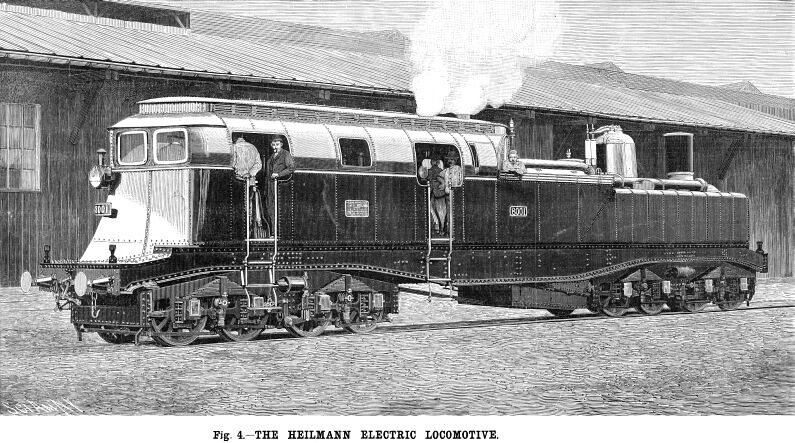
It is now some three years since Mr. J. J. Heilmann, of Paris,
designed and placed in operation his first standard gage electric
locomotive, which was known as La Fusee Electrique and was tested
upon the lines of the Compagnie des Chemins de Fer de l'Ouest,
of France. The Fusee was of 600 horse power and 120 tons weight
and it was designed for hauling the ordinary class of passenger
trains. The novelty of this locomotive consisted in the fact that
it did not take its current from a feeder connecting with a distant
power station, but carried its power station with it—the
boiler, engine, generators, and motors being all combined in one
machine upon one set of wheels and comprising an absolutely self-contained
electric locomotive.
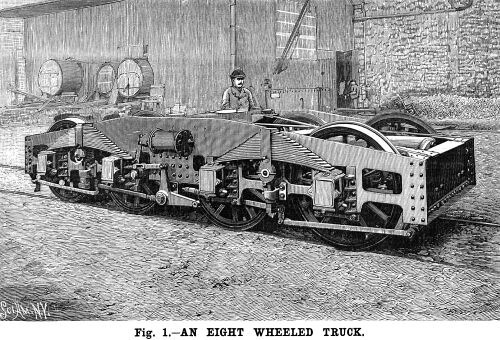 In spite of
a vast amount of adverse criticism based on theoretical a priori
grounds the builders of the Fusee were so well satisfied with
its performance that they have constructed two more locomotives
of the same type, but having much greater power and embodying
the improvements suggested by the trials above referred to. By
the courtesy of the builders we present a series of views of the
first of these engines taken during its construction at the shops. In spite of
a vast amount of adverse criticism based on theoretical a priori
grounds the builders of the Fusee were so well satisfied with
its performance that they have constructed two more locomotives
of the same type, but having much greater power and embodying
the improvements suggested by the trials above referred to. By
the courtesy of the builders we present a series of views of the
first of these engines taken during its construction at the shops.
The designs of the Heilmann locomotive have been subjected
to considerable criticism, mainly on the ground that it is at
an evident disadvantage compared with the ordinary steam locomotive,
because it necessitates an extra conversion of power, with its
inevitable attendant loss. But while the loss in conversion is
admitted, it is claimed by Mr. Heilmann that there are valuable
compensations to be realized. In the first place, the absence
of reciprocating parts and counterbalance weights secures a perfectly
balanced engine which is easy upon the track and bridges. There
is a further economy, it is contended, in the use of a many-cylindered
high speed engine, and although considered as an electric motor,
there is a greater weight of machinery to be carried than in a
motor driven from a central station, this is offset by the absence
of any loss by transmission over a line of greater or less length.
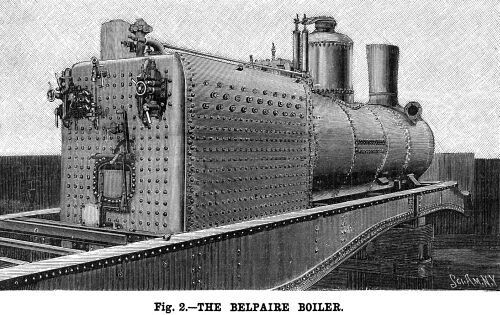 Regarding
the first claim that this type of locomotive is perfectly balanced
there can be no dispute, and the designer is entitled to full
credit for having solved one of the most difficult problems connected
with high speed locomotives. In the ordinary type the evil effects
of "excess balance" are met or mitigated by the use
of large driving wheels. This, however, necessitates a slow piston
speed and a corresponding reduction of the indicated horse power.
In the Heilmann machine the main engine is completely balanced
by the arrangement of the six cranks, and the tests which have
taken place show that there is a complete absence of the well
known hammering and plunging effects noticeable in the ordinary
locomotive. Regarding
the first claim that this type of locomotive is perfectly balanced
there can be no dispute, and the designer is entitled to full
credit for having solved one of the most difficult problems connected
with high speed locomotives. In the ordinary type the evil effects
of "excess balance" are met or mitigated by the use
of large driving wheels. This, however, necessitates a slow piston
speed and a corresponding reduction of the indicated horse power.
In the Heilmann machine the main engine is completely balanced
by the arrangement of the six cranks, and the tests which have
taken place show that there is a complete absence of the well
known hammering and plunging effects noticeable in the ordinary
locomotive.
It will be argued that the ordinary electric motor is also
balanced, and that the extra load of boiler, engines and generator
area distinct handicap to this engine. To this it must be answered
that in a locomotive of 1,350 horse power, which it is claimed
the new machines will develop, the load of boiler, engines, etc.,
is almost necessary to give the requisite adhesion when the locomotive
is working up to full power, as in starting or on a steep grade.
It is evident that in proportion as the weight of the steam boiler,
engines and generators become necessary for adhesion, the advantages
of their installation in a separate power house disappear.
The above facts show that the design is per se not so altogether
indefensible as many of its critics have roundly declared; and
the aims of its designers appear yet more reasonable when they
state that in building the Heilmann locomotive an effort is being
made to make it possible to equip the trunk railroads electrically,
without making any radical changes in the road itself. With this
fact in view, it must be admitted that whether the arguments above
given are sound or not, this machine will enable the railroad
companies to experiment with electric traction on a limited scale
without undertaking the great expense which will be entailed in
the use of the central station system.

The machine is built upon a pair of deep plate girders and
carried by a couple of eight-wheel trucks, one under each end.
The total length of the engine over all is 61 feet and the rigid
wheel base measures 37 feet 3 inches. The front of the engine
is not, as one would suppose from looking at the engraving, the
end occupied by the boiler, the latter being placed over the rear
trucks, the forward half of the platform carrying the engines,
generators, exciters, etc. Water is carried in two tanks, one
on each side of the boiler, and the coal bunkers are situated
just ahead of the tanks and on each side of the fire box. The
engines, generators, etc., are completely housed in by a large
plate steel cab or casing which is given a sharp, plow-like form
at its forward end with a view to reducing the air resistance.
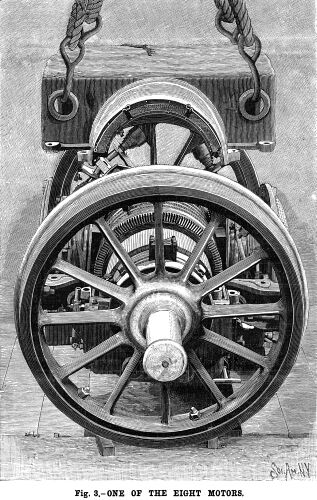 The boiler
of the first experimental locomotive was of the Lentz type, with
corrugated fire box and combustion chambers, but in the present
type the designer has returned to the ordinary locomotive style
of boiler, the fire boxes being, however, of copper and built
on the Belpaire pattern. There are 351 tubes 1.77 inch in diameter
and 12.5 feet long, and, there are 35.95 square feet of grate
surface, the total heating surface of the whole boiler being 1,996.5
square feet. The boiler pressure is 200 pounds to the square inch.
The generators are driven by a Willans compound six-crank vertical
engine, the cranks being set at 0 degrees, 120 degrees, 240 degrees,
240 degrees, 120 degrees and 0 degrees, by which arrangement the
difficulties of counterbalancing are completely overcome. In spite
of its high speed, the engine runs in perfect equilibrium. As
we have said, this is one respect in which Mr. Heilmann claims
a distinct advantage over the ordinary form of locomotive, in
which the well known counterbalance problem is causing no end
of trouble and expense. The boiler
of the first experimental locomotive was of the Lentz type, with
corrugated fire box and combustion chambers, but in the present
type the designer has returned to the ordinary locomotive style
of boiler, the fire boxes being, however, of copper and built
on the Belpaire pattern. There are 351 tubes 1.77 inch in diameter
and 12.5 feet long, and, there are 35.95 square feet of grate
surface, the total heating surface of the whole boiler being 1,996.5
square feet. The boiler pressure is 200 pounds to the square inch.
The generators are driven by a Willans compound six-crank vertical
engine, the cranks being set at 0 degrees, 120 degrees, 240 degrees,
240 degrees, 120 degrees and 0 degrees, by which arrangement the
difficulties of counterbalancing are completely overcome. In spite
of its high speed, the engine runs in perfect equilibrium. As
we have said, this is one respect in which Mr. Heilmann claims
a distinct advantage over the ordinary form of locomotive, in
which the well known counterbalance problem is causing no end
of trouble and expense.
There are two continuous current generators directly connected
to the main shaft, one at each end of the engine. The generators,,
which were built by Messrs. Brown, Boderi & Company, are continuous
machines coupled in parallel, and each has a capacity of about
1,000 amperes at 450 volts. They are excited by a small four-pole
self-exciting dynamo which is driven by a simple Willans engine
of about 28 horse power. The current is led to eight motors, one
for each axle of the trucks. The motors have four poles, with
two field cores placed horizontally. The field winding is an insulated
copper strip and the armature is a toothed drum wound in series
and mounted on a hollow steel shaft which carries at one end a
disk. This disk transfers the motion to the axle by means of three
powerful links which are carried upon three corresponding pairs
of springs secured between the arms of one wheel. The arrangement
is shown in Figs. 3 and 5 in the accompanying illustrations. The
axle passes with sufficient clearance through the hollow shaft,
and the springs have sufficient flexibility, even under the full
power of the motor, to allow free movement of the hollow shaft.
The motors are all connected in parallel and each motor is fed
by a special circuit from the switchboard and has its own switch
and automatic cutout. For low speed and under heavy loads the
motors may be grouped in a series of four by means of a controller.
There is an eight-way switch for reversing the current in the
armatures of the motors and for instantaneously changing their
direction. The speed may be varied by means of a rheostat placed
in the exciting circuit of the generators.
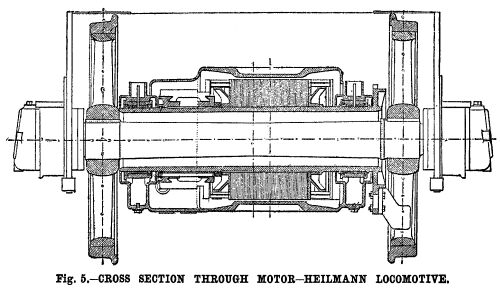 The controlling
gear is arranged in duplicate, one set being placed at the forward
end of the locomotive and the other near the boiler in the position
usually occupied by the throttle and reversing lever in an ordinary
locomotive. This is done to enable the engine to run in either
direction. It is claimed by the makers that these locomotives
will take a train of nearly 400 tons at a speed of 62 miles an
hour. We are informed that the preliminary trials, of which we
do not as yet possess the details, give reason to expect that
when they are in active service these locomotives will be capable
of performing the full duty for which they are designed. The controlling
gear is arranged in duplicate, one set being placed at the forward
end of the locomotive and the other near the boiler in the position
usually occupied by the throttle and reversing lever in an ordinary
locomotive. This is done to enable the engine to run in either
direction. It is claimed by the makers that these locomotives
will take a train of nearly 400 tons at a speed of 62 miles an
hour. We are informed that the preliminary trials, of which we
do not as yet possess the details, give reason to expect that
when they are in active service these locomotives will be capable
of performing the full duty for which they are designed.
Stories Page | Contents Page
|







